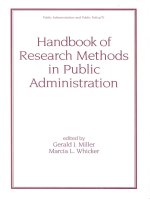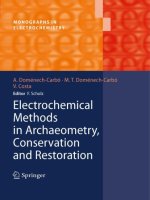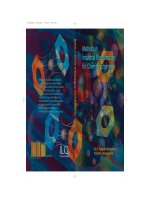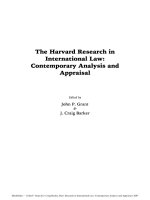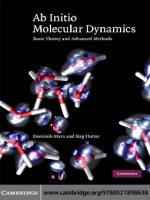current methods in forensic gunshot residue analysis
Bạn đang xem bản rút gọn của tài liệu. Xem và tải ngay bản đầy đủ của tài liệu tại đây (5.02 MB, 172 trang )
Current Methods in
FORENSIC
GUNSHOT
RESIDUE
ANALYSIS
©2000 CRC Press LLC
Current Methods in
A. J. Schwoeble • David L. Exline
FORENSIC
GUNSHOT
RESIDUE
ANALYSIS
Boca Raton London New York Washington, D.C.
CRC Press
©2000 CRC Press LLC
This book contains information obtained from authentic and highly regarded sources. Reprinted material
is quoted with permission, and sources are indicated. A wide variety of references are listed. Reasonable
efforts have been made to publish reliable data and information, but the author and the publisher cannot
assume responsibility for the validity of all materials or for the consequences of their use.
Neither this book nor any part may be reproduced or transmitted in any form or by any means, electronic
or mechanical, including photocopying, microfilming, and recording, or by any information storage or
retrieval system, without prior permission in writing from the publisher.
The consent of CRC Press LLC does not extend to copying for general distribution, for promotion, for
creating new works, or for resale. Specific permission must be obtained in writing from CRC Press LLC
for such copying.
Direct all inquiries to CRC Press LLC, 2000 N.W. Corporate Blvd., Boca Raton, Florida 33431.
Trademark Notice: Product or corporate names may be trademarks or registered trademarks, and are
used only for identification and explanation, without intent to infringe.
© 2000 by CRC Press LLC
No claim to original U.S. Government works
International Standard Book Number 0-8493-0029-0
Library of Congress Card Number 00-030353
Printed in the United States of America 1 2 3 4 5 6 7 8 9 0
Printed on acid-free paper
Library of Congress Cataloging-in-Publication Data
Schwoeble, A. J.
Current methods in forensic gunshot residue analysis / by A.J. Schwoeble,
David L. Exline.
p. cm.
Includes bibliographical references.
ISBN 0-8493-0029-0
1. Forensic ballistics. I. Exline, David L. II. Title.
HV8077.S34 2000
363.25′62—dc21 00-030353
CIP
©2000 CRC Press LLC
Preface
Gunshot residue (GSR) examination is a specialized discipline of forensic
science. Techniques for examining GSR have evolved from simple color tests
to modern analytical methods. This book details current methods of GSR
analysis for professionals who utilize this type of evidence in their work and
introduces the subject to laypeople interested in learning about this ever-
changing field.
The concept of this text was formulated with current methods of GSR
in mind. A comprehensive text on the examination of GSR was compiled
more than 20 years ago in a publication called the Aerospace Report No.
ATR-77(7915)-3. To date, the Aerospace Report is the most comprehensive
text available about GSR. Since that time, advancements have been made in
the way GSR evidence is examined in laboratories worldwide, and many
laboratories have modified the classification of certain particles derived from
this type of evidence. This book is not meant to replace the extensive research
compiled by the Aerospace Report, but rather to supplement that report and
many other quality research papers that have been published over the past
20 years.
This text concentrates on certain areas that we consider most important
to examiners in the law enforcement community and students of criminal
justice and forensics. Chapter 1 discusses the significance of GSR evidence,
collection criteria, and general topics. Chapter 2 examines particle formation
and presents a current classification scheme for GSR evidence. The classifi-
cation of particles is an important aspect of GSR evidence that is evolving
as research in this area continues. A general overview of scanning electron
microscopy energy dispersive spectroscopy (SEM/EDS) is presented in some
detail in Chapter 3. This chapter will educate both bench examiners and
students about this powerful method of analysis, now at the forefront of GSR
examination. General theory, computer-controlled scanning electron micros-
copy (CCSEM), and variable pressure scanning electron microscopy are dis-
cussed.
Chapter 4 details a study of “plume” concentrations. The importance of
how GSR is deposited on the hands of shooters with various types of firearms
is a significant aspect of GSR interpretation. The various amounts and areas
©2000 CRC Press LLC
of deposition of GSR for firearms such as revolvers, pistols, rifles, and shot-
guns are explained and compared. A possible mechanism to estimate particle
fallout is also described.
No explanation of GSR would be complete without a general overview
of commonly used firearms and ammunitions. In Chapter 5 we attempt to
educate the reader on the general types of firearms used today and the
components of commonly used ammunition types. Chapter 6 summarizes
general guidelines for note taking, report writing, and courtroom consider-
ations for the expert witness.
This book presents the reader with an overview of current methods of
examination and interpretation used by the authors and examiners in the
law enforcement community. Our hope is that the reader will combine the
knowledge provided in this book with past and current literature about GSR
examination, and thus continue the evolution of this valuable area of forensic
science.
©2000 CRC Press LLC
The Authors
A. J. Schwoeble is Manager of Forensic Sciences and Special Projects, respon-
sible for forensic analytical services and for designing, implementing, and
reporting specialized testing programs for RJ Lee Group, Monroeville, PA.
At RJ Lee Group, Mr. Schwoeble played a key role in developing latent
fingerprint technology and the adhesive-lift technology used for sampling
skin and fabric for trace evidence applications and for surface and indoor
ambient air particulate sampling. He was a principal architect for computer
software to perform gunshot residue (GSR) analysis. He is presently consult-
ing with a Swiss law enforcement agency for the analysis of GSR produced
from foreign manufactured ammunition, and conducting the examination
of clean fire primers of U.S. manufacturers.
Mr. Schwoeble has consulted with the FBI and other law enforcement
agencies on automated microscopy and sample collection techniques for the
analysis of GSR and other trace evidence. He performs GSR analysis and
particle analysis for over 150 law enforcement agencies and attorneys in the
United States, Australia, and Switzerland. His forensic investigations incor-
porate the use of optical, scanning electron, and transmission electron
microscopy, atomic absorption (AA), and micro-FTIR (Fourier Transform
Infrared Spectroscopy). Mr. Schwoeble has qualified as an expert for GSR
analysis in several states. He has been an invited speaker at meetings of the
ICEM-14, ENFSI, MAFS, SAFS, CAFS, and MAAFS.
Prior to joining RJ Lee Group in 1986, Mr. Schwoeble acquired over
25 years of research and materials analysis experience at the Naval Research
Laboratory, Washington, D.C., the United States Steel Research Center,
Monroeville, PA, and Allegheny Ballistics Laboratory, Pinto, WV. He is the
author of numerous publications. He was the 1984 recipient of the ASM
Henry Marion Howe Award as the author of the published paper of highest
merit in metallurgical transactions.
David L. Exline is a forensic scientist with RJ Lee Group, where he examines
GSR, hairs, fibers, paints, and other forensically significant trace evidence.
Before joining RJ Lee Group in 1998, Mr. Exline was a forensic scientist with
the Anne Arundel County Police Department Crime Laboratory, Millersville,
©2000 CRC Press LLC
Acknowledgments
We wish to thank the following individuals:
Dr. Richard Lee, for his encouragement, technical support, and generosity in the
use of the laboratory and instrumentation, and for giving us a free hand to
conduct research and experimentation
William Powers, Sr., for his contributions in test firings and his invaluable
expertise in firearms and ammunition, which is evident throughout this text
Hank Beebe of RJ Lee Group, Inc. for the engineering expertise he brought to
all aspects of our analyses using scanning electron microscopy (SEM)
Dr. Stephen Kennedy of RJ Lee Group, Inc., for his insight and contributions to
the SEM chapter
Dr. Fred Schamber of RJ Lee Instruments, for his input and editing of the SEM
material
Keith Wagner of RJ Lee Group, Inc. for his contribution dealing with GSR
particle fallout calculations from discharged firearms
Cindy Lodor, for her invaluable behind-the-scene organizational abilities
Hank Lentz, for the immense time he spent with GSR experts around the
country, whose input he then used to create the software for automated GSR
analysis
Josh Newlin for his expertise in graphics and photography
Jim Nesbitt and Ray Callihan for their direction and participation in the pro-
duction of the video analysis of plume concentrations described in this book
The team members of RJ Lee Group, Inc. for their efforts and support in the
test firings of multiple weapons and ammunition studies
The authors would also like to express their appreciation to Dennis Ward and
John Krall of the FBI, Kenneth Culbreath of the NCSBI, and Joseph Powell
of the SCLED for their consultation and aid during the plume study.
©2000 CRC Press LLC
To our wives, Nancy Schwoeble and Jennifer Exline
Their patience and support allowed us to spend many nights and
long hours compiling data, writing, and organizing the
contents of this book, which took us away from family life
for extended periods of time
©2000 CRC Press LLC
Table of Contents
1
Gunshot Residue as Forensic Evidence
Introduction
Value of GSR as Trace Evidence
Degradation of GSR
Transfer of GSR
Specific Areas of GSR Deposition
Collection of GSR Evidence
General Crime Scene Considerations
Examination of GSR
References
2
Explanation of Gunshot Residue
Particle Formation
Classification of GSR Particles
Are All GSR Particles Spherical?
Shape and Texture of GSR
Morphologies of Known GSR Particles from Test Firings
Uniqueness of Composition
Terminology
Environmental Considerations in GSR Examination
References
3 Methods for Examination of Gunshot Residue
Principal Techniques
Scanning Electron Microscopy/Energy Dispersive Spectroscopy
Theory of the SEM
Features of the SEM
How the SEM Works
The Column
Column Issues
©2000 CRC Press LLC
Beam/Sample Interaction
Detectors
Electron Detectors
Imaging
Imaging Considerations
X-Ray Detectors
X-Ray Artifacts
Working Distance
EDS Considerations
Automated SEM Analysis
Variable Pressure SEM
Case Study 1
Case Study 2
Case Study 3
Case Study 4
Discussion of Variable Pressure SEM
Other Methods of Analysis
Color Tests
Bulk Methods of Analysis
Graphite Furnace Atomic Absorption Spectroscopy
(GFAAS)
Neutron Activation Analysis (NAA)
Inductively Coupled Plasma-Mass Spectroscopy (ICP-MS)
Capillary Electrophoresis (CE)
References
4
A Study of Plume Concentrations
The Plume Study
Summary of Results
Particle Fallout
Conclusions
References
5 Ammunition
Firearms
Rifles
Shotguns
Pistols
Cartridges
©2000 CRC Press LLC
The Cartridge Case
Rimfield Cartridge
Centerfire Cartridge
Cartridge Casing
Bullet
Powder Charges
Primer
Head Stamps
.22 Caliber Ammunition Composition
Ammunition Composition Studies
GSR Studies: U.S. Manufacture Pistol Primers
General Observations from Test Firings
Revolvers vs. Semi-Automatics
References
6 Documentation of Evidence and Testimony
Note Taking
Report Writing
Chain of Custody
Expert Testimony
General Questions and Possible Explanations
Expert Qualifications
Background Questions
Glossary
Bibliography
©2000 CRC Press LLC
Gunshot Residue
as Forensic Evidence
Introduction
Forensic science may be defined as the application of various scientific dis-
ciplines to aid the criminal justice system. Gunshot residue (GSR) evidence
is an area of forensic science that is often underestimated and underappre-
ciated by the forensic community. It is certainly one of the most underutilized
types of physical evidence. The staggering increase in firearms-related
offenses in the U.S. has intensified the importance of rapid and accurate GSR
analysis. In a recent report, the Federal Bureau of Investigation (FBI) cites
firearms as the weapons of choice in over 30% of 1.7 million incidents of
violent crime.
1
This book was written in response to the growing realization of the
significance of GSR as evidence and the lack of textbooks that discuss current
developments in this area of forensics. Despite advancements in analytical
techniques and adjustments to the classification of GSR particles, no text
that discusses these developments has been produced. In particular, this
book provides a unique resource to help examiners at every level better
understand current methods of analysis. The book will also aid experienced
examiners by highlighting other areas that have been refined since guidelines
were set forth by the Aerospace Report of 1977.
2
The Aerospace Report was
a landmark study of GSR, and the information it provided to the forensic
community was invaluable to GSR examiners. Since that time significant
developments have occurred in the area of GSR analysis. For example,
methods such as computer-controlled scanning electron microscopy
(CCSEM) now offer the means to examine thousands of particles per sample
in a relatively short period of time (approximately 2 hours vs. 8- to 12-hour
examinations per sample using manual microscopy methods), depending
on the particles present on the sample.
We hope that this book will spark interest in this ever-expanding disci-
pline and encourage both experienced and novice scientists to revisit GSR
interpretation and characterization in forensic casework.
1
©2000 CRC Press LLC
Value of GSR as Trace Evidence
Trace evidence is a type of physical evidence that is often not detectable to
the naked eye. Often, some type of magnification or sensitive analytical
technique is required to adequately characterize the evidence. GSR evidence
is one of the most common and most heavily scrutinized sources of trace
evidence examined in violent crime investigations. Understanding GSR and
its value as significant trace evidence can aid in the investigation of violent
crimes involving firearms. GSR may directly link an otherwise unknown
subject to an environment of weapon discharge.
For GSR evidence to be significant, many factors must be considered.
GSR is typically found on the hands or clothing of persons who have been
in the environment of a discharging firearm, but it may also be found on
objects in the vicinity of discharge. It is vital for law enforcement personnel
to understand how GSR is created and deposited and how such evidence is
collected.
Because the methods of collection and analysis are so varied, it is of
utmost importance for those who collect and examine this evidence to be
aware of the importance of preserving its potential value. Forensic examiners,
evidence collection officers, police officers, EMS personnel, medical profes-
sionals, and anyone who comes in contact with suspects and victims follow-
ing a violent crime must understand the potential existence and significance
of GSR evidence. Investigators must corroborate or disprove stories, confirm
or contradict suicides, and evaluate scenarios where there are no eye witnesses
or other types of investigative leads. For these individuals, education about
forensic evidence and training in the area of evidence collection and recog-
nition are essential. It is important to understand the different types of
sampling media used in the collection of trace evidence and which type is
appropriate for particular crime scene conditions or material to be tested.
The most commonly asked question when a crime involving a firearm
has occurred is “Who fired the gun?” (or in the case of a suicide, “Are we
sure the victim actually fired the gun?”). These questions can often be
addressed simply by taking the time to correctly collect the evidence and
properly analyze the samples in the laboratory.
Another common question that arises when GSR is present is “Can you
be sure who fired the weapon?” The answer is not always clear. This is why
an understanding of how GSR is deposited, how it is collected, its persistence,
and the means of analysis are so critical. The examiner must consider all of
this information before forming any opinions.
As the reader progresses through this book, it will become apparent that
the answers to questions like those asked above are not clear-cut in many cases.
What can always be stated with certainty is that detection of GSR means a
©2000 CRC Press LLC
person or object was in the vicinity of a discharging firearm at some point in
time. If GSR evidence is not properly collected and correctly analyzed, other-
wise critical forensic evidence may well remain insignificant or totally unde-
tected. Over the past 40 years, various collection techniques and analytical
procedures have been developed and refined. Today, large numbers of samples
can be examined quickly to help investigators answer these difficult questions.
Degradation of GSR
Particles of GSR are very durable particles composed of heavy metals that
originate from the ammunition components. The inorganic particles that are
examined can last in a normal environment indefinitely. Although the actual
particles do not degrade under normal conditions, they may not remain on
the hands or clothing of a subject over time, because of the physical activity
of the subject.
Transfer of GSR
When the firing pin of a firearm strikes the primer cap of the ammunition,
a rapid high-temperature burning of the primer mix takes place. This event
occurs in a fraction of a second and creates what we refer to as GSR, as well
as other things. Particles are deposited on the hands, clothing, and surround-
ing areas on or near the shooter. The basic principle of trace and transfer
evidence is the Locard Exchange Principle.
3
This principle states that when
two objects come in contact with one another, an exchange of material takes
place. A common example of transfer evidence is when two garments come
in contact with one another. There may be a transfer of fibers from one
garment to the other. Secondary transfer may also occur when trace evidence
originally transferred to one object is subsequently deposited on another
surface and picked up by a second recipient object, such as a garment.
When one considers GSR evidence, as the firearm is discharged, the par-
ticles formed from the combustion products of the ammunition components
transfer to the surrounding area. Unlike most transfer evidence, no direct
contact is made between the hands and the airborne particulate. The partic-
ulate is simply deposited on the hand or surrounding surfaces. Other evidence
such as fingerprints from the subject can be transferred to the firearm. Just
as secondary transfer occurs in other areas of trace evidence, GSR may be
transferred from the hands to clothing or surrounding areas by contact. GSR
can be transferred from the backs and palms of the hands to other items
simply by rubbing the hands together or transferred from hands into pockets
by placing the hands in the pockets.
©2000 CRC Press LLC
It is important to understand how evidence such as GSR can be trans-
ferred and what significance this type of evidence plays when collected and
analyzed by experts who have evaluated the possibilities of these types of
situations. To properly evaluate transfer evidence it is important to under-
stand how these particles persist and the environment in which the transfer
has occurred. Populations of unique and characteristic GSR particles and
other lead-rich particles play an important role when one considers or forms
an opinion of what is direct deposition and what is possibly the transfer from
hands or clothing due to casual contact. Other variables to consider include
environmental conditions, weapon types, ammunition types, caliber, and
condition of the weapon. Test firing under static conditions, if the firearm is
available, can yield information on particle distribution and deposition in
the surrounding environment.
Specific Areas of GSR Deposition
Areas that yield the greatest potential for GSR deposition are investigated by
the authors in the plume study video discussed in Chapter 4. Discussion
focuses on the areas of highest concentration of GSR deposition — the hands,
clothing, and areas surrounding the shooter — using various types of fire-
arms. The information presented in this video can help the collection officer
determine what areas offer the greatest potential to recover GSR evidence.
A brief summary of key areas of GSR deposition follows.
Hands — The hands are the most common places that GSR is collected
from suspected shooters. With firearms such as revolvers, pistols, and
automatic weapons, a clear pattern emerges as to the areas of greatest
GSR deposition. Collection typically focuses on four regions of the
hands (right back, right palm, left back, and left palm).
Face — The face of the shooter can be sampled on occasions when
firearms such as rifles and shotguns are used in the shooting. Test
firings have shown that large amounts of GSR are deposited in these
areas when certain types of weapons are used that cause a condition
of blow-back toward the chest, face, and hair.
Clothing — Clothing often preserves GSR evidence even if the hands of
the shooter have been cleaned or longer periods of time have elapsed
from the time of the shooting and the time of collection. Test firings
using numerous types of firearms have resulted in large amounts of
GSR deposition on clothing.
Objects in the environment of GSR — Objects that are in the vicinity of
GSR may also provide valuable associative evidence that a shooting
©2000 CRC Press LLC
occurred in that area. When the plume of the discharging firearm is
created, the cloud spreads from all the openings in the firearm and
deposits on the areas in the immediate vicinity of the discharge. Exam-
ination of tables, chairs, walls, drapes, floors, beds, bedding, items of
furniture, and other indoor items may help determine where a shoot-
ing took place.
Cars — Drive-by shootings are unfortunately common in today’s world.
Methods have been developed to collect GSR from the interior and
exterior of automobiles involved in these types of crimes. It is not
uncommon for the collection officer who employs proper collection
methods to recover GSR evidence from automobiles. Seats, seat backs,
head rests, dashboards, doors, and headliners are subject to particle
extraction using sampling media designed for this application.
Collection of GSR Evidence
Numerous collection techniques are used to prepare samples for GSR analysis.
Depending on the technique of choice, protocols are available for the various
kinds of testing. For example, the collection officer may need to sample a wide
variety of surfaces, such as:
• Skin — hands, face, neck, etc.
• Vehicle surfaces — seat, seat back door, window, dashboard, or headliner
on interior or exterior
• Surrounding surfaces — doors, windows, and other body parts
• Clothing — coats, shirts, waistbands, gloves, boots, shoes, hats, etc.
• Any other surfaces in the immediate vicinity of firearm discharge
Although collection procedures vary from agency to agency in the U.S.,
one procedure that all organizations agree upon is that sterile gloves should
be worn when collecting any type of trace evidence. Areas of collection and
sampling media are quite different, as observed during a 2-year tour of crime
laboratories and agencies in the U.S. The two most widely used collection
media types are cotton swabs with a 5% nitric acid solution for Atomic
Absorption (AA) and Inductively Coupled Plasma (ICP) and adhesive stubs
for scanning electron microscope (SEM) analysis. These devices are com-
monly used to collect particulate from the hands, face, and other surfaces
including clothing, vehicle interiors, and areas in close proximity to a dis-
charged firearm. Swabs are also used to collect particulate from the nostrils
and ears of subjects suspected of involvement in the discharge of a firearm.
©2000 CRC Press LLC
Collection of samples with 5% nitric acid solution is the method of choice
for analytical techniques such as Atomic Absorption (AA), Inductively Coupled
Plasma (ICP), or Neutron Activation Analysis (NAA), but it is not a viable
sampling medium for scanning electron microscope (SEM) analysis. This is
because the nitric acid solution immediately starts to transform the solid par-
ticulate into solution, which is retained in the swab media. Virtually all other
collection media, such as adhesive stubs, tapes, clothing, skin, gauze, and dry
swabs, obtain viable particles for SEM GSR.
Collection areas and number of samples collected, whether by swabbing or
dabbing, are not standard throughout the U.S. Some agencies collect hand
samples from the back of each hand only. Others collect two samples, combining
the back and palm of each hand per sample. Most agencies use four samples:
right back, right palm, left back, and left palm. Generally, the areas sampled on
the back of the hands cover the index finger, the thumb, and the web area
between and behind the thumb and index finger and toward the wrist. Types
of adhesive samplers on the market include double-back tape, double-back
carbon tape, a multiple-adhesive-layer tape (which requires more extensive sam-
ple preparation before the analysis), and the freshly activated adhesive sampler.
Aluminum stubs that are coated with a polymerized adhesive must be
coated with a conductive layer or examined in the SEM using variable pres-
sure SEM, which is described in Chapter 3. The SEM equipped with a variable
pressure feature requires no special sample preparation and samples are
examined in the “as received” condition.
Some samples must be carbon (C) coated because of the nature of the
electrons that strike the sample. See Chapter 3 for a complete description of
the SEM and its interaction with the sample. The samples are removed and
examined in the SEM. The light C coating does not interfere with the analysis
of the sample; however, if this process can be eliminated, the possibility of
contamination or particle loss from additional handling of the sample during
the preparation of the sample for SEM analysis will also be eliminated.
Samples that are collected on double-sided aluminum tape may not be
coated prior to sampling because the C-rich background of the tape carries
off the electrical charge. This sampler and methods such as variable pressure
eliminate the need for C coating.
A multi-adhesive-layer stub, developed by Loren Sugarman in consulta-
tion with Dennis Ward, is a collection stub still used by many agencies for
GSR collection. The white cap is removed from the sampler and the stub is
pressed against a specific area of the hand (e.g., right back, right palm, left
back, and left palm) until the tackiness is gone. A slight rotation of the stub
while it is pressed against the sampling area will expose new adhesive, allow-
ing prolonged sampling. The cap is replaced and the sample is submitted to
©2000 CRC Press LLC
the laboratory for examination. This collection technique requires extensive
sample preparation prior to examination in the SEM.
Separate types of sampling media are used for particle extraction from
fabric. These types include permanently tacky adhesive stubs, double-sided
carbon tape, and adhesive strips for large areas. With an adhesive strip, a
large surface area such as a vehicle seat can be concentrated on a small sample
(i.e., a 2-in by-3-in. strip). A single strip may be used to collect particulate
from the entire seat area. To collect particulate from clothing, a shirt for
example, one stub is used for the right sleeve, a second stub is used for the
right front side of the shirt, a third stub is used for the left shirt sleeve, and
a fourth stub is used for the left front side of the shirt. Separate stubs are
required for each pant leg. Multiple samplings may be necessary, depending
on the coarseness of fibers in the fabric. For example, wool would require
more samplings than tightly woven nylon.
The main variables in sample collection are the efficiency of the sample
collection officer, the efficiency of the sample collection media, environmental
conditions, and the time lapse between the incident being investigated and
collection coupled with the physical activity of the subject being examined.
General Crime Scene Considerations
The first and most important consideration in dealing with GSR evidence is
the time factor. Studies have shown that, on a living person, GSR persistence
decreases with passage of time. It is very important to collect the evidence as
soon as possible after the suspected shooting. The standard time frame suggested
in the literature is 3 to 6 hours after the incident. But in some instances, GSR
can persist much longer, especially on clothing and deceased individuals.
Improved sampling media may also be a factor in extending the collection
time. Protocols vary among U.S. agencies on the effective time period for
collecting GSR from the hands of a shooter. Of course, this depends totally
on the physical activity of the individual and whether that activity involved
the skin or clothing.
Preservation of clothing obtained in the investigation is another impor-
tant consideration. Do not shake or overly handle clothing of suspects or
allow any evidence to be handled extensively or carelessly. Particle loss can
be minimized in many cases, and every effort should be made to preserve
any evidence that may associate a subject with a suspected shooting. Clothing
is a good medium for retaining GSR; unfortunately, its significance in GSR
investigations is often underestimated. It may be necessary later to determine
which area of clothing was exposed to the GSR “plume.” To aid in this
©2000 CRC Press LLC
evaluation, careful preservation of the clothing is important. An understand-
ing of how GSR is deposited in the area of the discharging firearm will also
be valuable to the examiner.
Gloves are the best means to ensure that GSR evidence does not come
into casual contact with police officers or other law enforcement personnel.
A police officer usually does the sample collection. Questions may arise later
as to whether the GSR that originated from firing a gun is in fact secondary
transfer from the collecting officer. To minimize the likelihood of such con-
fusion and possible accusations, always wear gloves when collecting evidence
at a crime scene or from a suspect involved in a crime.
A major misconception is that if you cannot see GSR evidence, it may
not be present. Just because you do not see GSR with the naked eye, do not
assume that GSR is not there. GSR particles are commonly 1 to 10 microns
(µm) in size, although they may range from <1 µm to >100 µm (a micron
is 0.00038 in.), so they may not be visible to the naked eye. The appearance
of clean hands or unsoiled garments should not lead one to assume that GSR
is not present. Conversely, black deposition on the hands or clothing may be
from sources other than GSR. You should collect samples even if you do not
see what you think GSR should look like. Trace evidence is so named for
good reason.
Always document where, when, from whom, and from what areas the
GSR was collected from the crime scene. This is critical when the scenario
of a crime is formed later in the laboratory. This is especially important when
clothing and objects suspected of being in the vicinity of a discharged firearm
are examined. GSR evidence has helped corroborate or disprove scenarios in
many cases, based solely on whether GSR was present in certain areas of
clothing or objects.
Examination of GSR
Any forensic examination begins with properly collected evidence at the
crime scene. Knowledge of the various collection techniques and areas of
GSR deposition are important for preserving the best evidence for later
analysis in the laboratory. Carefully document your crime scene or collection
of the evidence. Knowing when and from where the evidence was collected
is important for later evaluation of the evidence. It may be necessary to collect
GSR at the scene of the crime or shooting. In such cases, the collection officer
should understand the various collection methods and collection media
available to the immediate law enforcement community.
Laboratory examination is the next step. Samples are prepared, and if
necessary, the GSR is examined and evaluated. Various techniques, which we
©2000 CRC Press LLC
will discuss later, depend on the efficiency of the collection at the crime scene
or the subject. Interpretation of the evidence is not as simple as finding a
particle or comparing a concentration of known threshold levels and con-
cluding that a subject may or may not have fired a weapon. An understanding
of various factors, such as primer formulations and environmental sources
of elements similar to GSR, is critical for interpretation of GSR.
A clear and concise report is an important step in the analysis. The job
of the examiner is not finished after the examination is complete; the job is
really just beginning. It is the duty of the examiner to help everyone involved
in the case to understand what was found and its significance to the case.
The effectiveness of the examiner in conveying this information varies and
depends largely on the individual’s experience and training. Last, and most
important, is the duty of the examiner to tell his or her results to the trier
of fact. Whether the trier of fact is the judge, jury, or grand jury, the exam-
iner’s interpretation of the evidence is critical in helping those who are not
experts in the area of GSR understand the pros and cons of what the evidence
really means.
Our hope is that this book will lead to a better understanding of GSR
and its current role in trace evidence examination.
References
1. Department of Justice, Federal Bureau of Investigation, Uniform Crime
Report, Crime in the United States 1997, U.S. Government Printing Office,
Washington, D.C., 1997.
2. Wolten, G. M., Nesbitt, R. S., Calloway, A. R., Loper, G. L., and Jones, P. F.,
Final Report on Particle Analysis for Gunshot Residue Detection, ATR-77
(7915)-3, The Aerospace Corporation, El Segundo, CA, 1977.
3. Locard, E., Dust and its analysis, Police J., 1, 177–192, 1928.
©2000 CRC Press LLC
Explanation of
Gunshot Residue
Many types of gunshot residue (GSR) analysis are described throughout this
book. This chapter deals with the definition of GSR, the mechanism in which
GSR is formed and distributed into the environment of the discharged fire-
arm, and current classification schemes for GSR particles. A general descrip-
tion of some common environmental sources of lead (Pb), antimony (Sb),
and barium (Ba) is presented.
When the primer mix burns, it escapes from the gun in the form of a
vapor or “plume” through any available openings in the weapon. It then
solidifies into fine particles and settles onto the hands, clothing, and surfaces
in the immediate proximity of the discharged weapon. Immediate proximity
varies from weapon to weapon; it is defined by the configuration and con-
dition of the weapon. Other factors that control the effect of particle disper-
sion include ammunition, be it the manufacturer load or self-loaded
cartridges, or the caliber. Air turbulence caused by environmental conditions
from either indoor or outdoor currents may influence the flight and disper-
sion of airborne particulate. Revolvers, semi-automatics with left and right
ejection ports, produce different directional plume patterns. These are dis-
cussed in Chapter 4, A Study of Plume Concentrations.
The discharging of a firearm initially produces a plume of airborne
particulate from the burning primer mix that deposits on any available sur-
face. The particulate of interest is composed of Pb, Ba, and Sb, in varying
proportions, and other components of the primer compound. In addition
to these inorganic components, many organic components are present in the
primer and gunpowder. The combusted material escapes the weapon through
the openings as vapors and solidifies as particulate that varies in shape and
size from submicron to over 100 microns (µm). GSR analysis determines the
presence of these materials on the skin and clothing of subjects and surfaces
such as vehicle interiors and exteriors where the particulate may be deposited.
2
©2000 CRC Press LLC
The small, round insert at the bottom of a cartridge casing is called the
primer cap. It contains a paste or mixture of primer compound. Three major
components in the primer compound play important roles in the formation
and identification of GSR:
• The Initiator — lead styphnate, which is set off with a sharp blow, as
when the firing pin strikes the primer cap;
• The Oxidizer — barium nitrate, which gives up its oxygen readily; the
oxygen is needed to burn the fuel;
• The Fuel — antimony sulfide, which burns at a very high rate; the
purpose of this initial burn is to ignite the gunpowder, which propels
the bullet.
Particle Formation
The formation of GSR has been studied in detail.
1–4
The elemental compo-
sition of GSR particles may vary depending upon the type of ammunition
used, but the method of particle formation is generally accepted in the
forensic science community. Understanding particle formation enables the
investigator to differentiate GSR particles from environmental sources of Pb,
Sb, and Ba.
Because GSR primer particles are formed by the rapid cooling of vapor-
ized Pb, Sb, and Ba following the high-temperature burn of the primer
compound, particles of GSR take on characteristic morphologies. Basu
1
describes three classifications of GSR primer particles:
1. Regular spheroids, which are uniformly round particles ranging in size
from 1 to 10 µm;
2. Irregular particles, which are formed by the fusion between smaller
and larger particles resulting in nodular spheroids;
3. Particles that form as a layer of lead surrounding an inner core of Ba
and Sb.
Particles formed in the interior of the firearm or contained in the car-
tridge may contain other types of formation. An explanation of particle
formation by Wolten and Nesbitt discusses bullet-derived GSR particles.
4
This is an important issue when one compares the morphology and particle
formation of known cartridge casings and uses that information to examine
particles found on the hand of a suspected shooter.
©2000 CRC Press LLC
Classification of GSR Particles
Are All GSR Particles Spherical?
The Aerospace Report
5
states that “70–100 percent of the unique particles in
a sample of GSR residue are spheroidal.” The morphology and the relative
brightness of the heavy metal particles enabled early examiners to detect
possible unique particles and distinguish them from background material.
In the early days of manual microscopy, an examiner spent long hours on
one sample looking for small, round, bright white particles, staring at field
after field of magnifications, hundreds of particles per sample. These exam-
iners did exceptional work, considering the methods they had at their disposal.
With the advent of computer-controlled scanning electron microscopy
(CCSEM) an automated system now detects all potential GSR particles con-
taining any heavy metals characteristics. The examiner can then relocate to
the specific particle, already shown to have possible chemistry consistent with
GSR. The examiner no longer has to manually search, since all particles
spheroidal and amorphous are examined for chemistry unique to and char-
acteristic of GSR. The alleviation of the manual approach enables the examiner
to focus only on certain particles consistent with GSR.
With today’s automated GSR systems, examiners look at thousands of
particles in 10% of the time previously required. The CCSEM does all the
time-consuming work of screening for potential GSR particles. As a result,
only those particles with significant elemental compositions are reviewed
manually to classify particles.
If an examiner were to examine all amorphous particles that exhibited
heavy metal characteristics, the process would be too time-consuming for
samples with heavy concentrations of metal particles, not all of which are
unique to GSR composition. Using CCSEM techniques, a high number of
amorphous particles are detected that contain the elemental composition
unique to GSR. The following study evaluates the amount and the particulate
morphology of GSR particles as detected using the CCSEM/Energy Disper-
sive Spectroscopy (EDS) system.
Shape and Texture of GSR
GSR particles are generally spherical in shape; however, collections taken
immediately after test firings yield particles with varying morphologies and
surface textures. Many particles show overall cracking characteristics with
edges that are straight or jagged to partially rounded. When sampling is
performed immediately after weapon discharge, and before any physical
activity takes place, a true representation of particle size and distribution,
©2000 CRC Press LLC
shape, and morphology can be observed and analyzed. When populations of
particles are examined under these conditions, it is readily apparent that GSR
particles are not limited to spherical, bright particles less than 10 µm in
diameter. In fact, the distribution of particles from samples taken from var-
ious primer/ammunition manufacturers have been analyzed with similar
results. Large populations of irregularly shaped GSR particles are present in
all the primer residues.
As the various GSR particles collected from the shooter’s hands immedi-
ately following the discharge of a firearm show (see Chapter 5), a wide range
of particle size distributions and shape factors govern GSR particles. In many
large particles, the surface cracking shows the potential breakup into smaller
particles with straight edges. Even the cracking through spherical particles
reveals the potential for irregular shapes with combinations of straight- and
rounded-edge particles. With physical activity, i.e., rubbing and clenching of
hands, these particles may be lost or broken into several sections and redistrib-
uted over the skin and clothing of the shooter. Certainly many spherical par-
ticles remain intact and in agglomerated form; however, the irregularly shaped
particles with the unique composition of GSR should not be disregarded.
Morphologies of Known GSR Particles from Test Firings
Two revolvers, a Colt Trooper .356 and a S&W 1917 45, and two semi-automatic
weapons, a S&W MOD 39-9mm and a Colt 1911A1 45, were test fired in
multiple firings using ammunition from four manufacturers (CCI, FED, REM,
and WIN). A sampling of the data from the CCSEM analyses, evaluating the
unique particles only for shapes of these particles (spheroidal vs. irregularly
shaped), revealed the following information.
1. For the revolvers, 74% of the particles analyzed were spheroidal and
26% were irregularly shaped.
2. For the semi-automatic weapons, 59% of the particles were spheroidal
and 41% were irregularly shaped.
3. In addition, by size, in the revolvers, 65% of the particles were <3 µm,
28% were 3 to 6 µm, 5% were 6 to 10 µm, and 2% were >10 µm.
4. For the semi-automatic weapons, 48% of the particles were <3 µm in
size, 29% were 3 to 6 µm, 9% were 6 to 10 µm, and 14% were >10 µm.
The results of this limited evaluation of test-firing particles indicate that
when an analyst has relocated and observed countless flagged particles with
unique and characteristic chemistry, the experienced eye of an examiner is
capable of evaluating the possible source of spherical and irregularly shaped
particles. In many cases, the examiner can visually interpret agglomerations
©2000 CRC Press LLC
